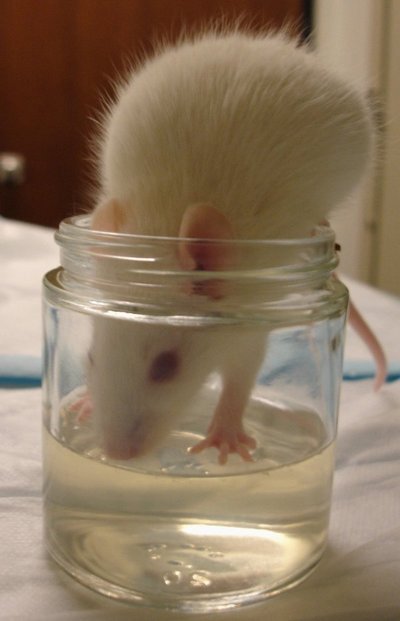September 21, 2009
Adolescent alcohol exposure may lead to long-term risky decision making
Picture this. A bunch of adolescent rats walk into a bar and start consuming Jell-O shots. Lots of them.
Then, three weeks later, some of those party rats are given the choice of pushing one lever that always will give them two sugary pellets or another lever that will give them a larger but uncertain reward of either four or zero treats. The alcohol-consuming rats tend to opt for uncertain rewards while a control group of teetotaling rodents match their choice well to whichever lever had the probability giving the larger reward.
That’s what happened in a scenario created by University Washington scientists investigating the neurobiological underpinnings of a link between adolescent alcohol abuse and later adult decision-making impairments. The research, being published this week in the online edition of the Proceedings of the National Academy of Sciences, appears to show a causal link between early heavy drinking and adult decision-making.
“We know early exposure to alcohol and other substances is a predictor of later substance abuse in humans. It is a novel concept to think that early exposure might have long-term cognitive effects. But we can’t test this on people. This model using rats lends support to causal link between early alcohol use and later increased risky decision making,” said Nicholas Nasrallah, a UW psychology doctoral student and co-author of the study.
“We can’t establish causal links based on existing human data but this animal model allowed us to establish this link,” said corresponding author Ilene Bernstein, a UW professor of psychology and faculty member of the program in neurobiology and behavior.
“Scientists believe regions of the brain, including those implicated in decision making, are slow to develop and development extends into adolescence. This study shows that these late-developing structures in rats are affected by high alcohol use.”
Rats typically do not drink alcohol, but researchers have found that they will consume ethanol when it is combined with gelatin. For this study, one group of rats was given 24-hour access to a 10 percent solution of ethanol in a tasty gel. The rats were 30 to 49 days old during the experiment, a time span that corresponds to human adolescence. These rats consumed the alcohol-laced gel each day, in amounts equivalent to a large number of drinks in human terms, Bernstein said.
A separate control group of rats was given a gel made without any alcohol. At the end of the 20 days the gelatin was withdrawn from both groups. Three weeks later, half of the animals from each group were trained to press the levers to receive the treats. Part of the training included what is called a forced choice where there was only one lever to press. This gave the rats an opportunity to sample the pay off schedule on the uncertain lever that day. Three days of trials were run with the payoff for the large but uncertain reward coming 75 percent of the time and then dropping to 50 percent and 25 percent on subsequent days.
The alcohol-exposed rats showed a strong bias toward the uncertain lever, even when the chance of receiving rewards on the third day diminished to only one in four. The control rats, however, behaved differently and adjusted perfectly to the changing conditions of the experiment, thus gaining more treats than the alcohol-exposed rats.
A second experiment tested whether effects of adolescent alcohol exposure were persistent by waiting three months after the gelatin was withdrawn before testing the remaining rats. The effects were the same suggesting that the influence of adolescent alcohol exposure on decision making does not diminish over time.
“The known association between behavior and high levels of alcohol use puts people at risk for a number of bad outcomes, particularly substance use,” said Bernstein. “Age of exposure to drugs is the No. 1 factor predictive of substance abuse later in life. Adolescent drinking is an epidemic today. This research raises a concern that if the brain is permanently changed by alcohol we need to place more emphasis on preventing adolescent alcohol use.”
The National Institute on Drug Abuse and the National Institute on Alcohol Abuse and Alcoholism funded the research. Tom Yang, a former UW undergraduate student, was a co-author of the paper.
###
For more information, contact Bernstein at 206-543-4527 or ileneb@u.washington.edu ; Nasrallah at 206-685-2905 or nicknas@u.washington.edu

